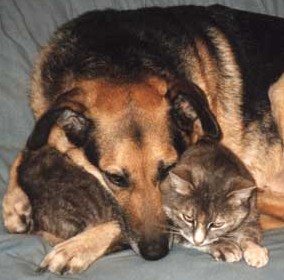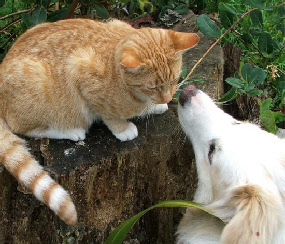© 2008 Hampstead Animal Hospital

Introducing Dogs & Cats
Don't get a cat if:
*Your adult dog is a breed or cross thereof that is known for high prey drive such
as husky-
*Your dog has demonstrated a high "critter drive." (regularly seeks out and chases small animals on walks, etc)
*You don't have a way to separate the animals for the first 6 weeks.
Adding a cat to a dog household
Your new cat needs at least one safe place to toilet and eat, and also a few places escape unwanted attention. Before getting the cat, set up a litter box and cat food and water area in a place the dog does not have access to. If you don't do this you run the risk of the cat toileting in the wrong areas. Some cats get so offended by the new dog that they stop using the litter box, usually just temporarily but sometimes permanently. To prevent this set up the litter box in a place where the cat doesn't have to risk running into the dog to get to it. This will also get the dog used to not being allowed in certain places before the cat comes. You can get a baby gate and put it across a doorway, add a small cat door to your basement door, etc. DOGS EAT CAT POOP and DOGS LOVE CAT FOOD. Be prepared!
When you get the cat, take the dog totally out of the picture for a few hours...board it with a relative or keep it outdoors or in your car. Allow the cat the chance to explore its new environment without having to deal with the dog. Carry the cat to the litter box area and bar it in that room for a few minutes to allow it to explore fully, then allow access to the rest of the house. The cat may panic and try to hide under a bed or something...if this happens, plan to keep the cat in the litter box room for a day or so, so that it will at least be close to its food and toileting area. Gradually allow access to the rest of the house.
On first meeting the dog, do it from behind baby gates so that the cat can have control of the approach. Have your dog on leash and immediately take the dog away if it starts to bark or get too excited.
Settle in for the long haul...the dog will probably be very interested in the cat and the cat will probably run and the dog will probably chase. Keep your dog on leash a lot for the first few days to prevent outright madhouse, and try to keep the dog's excitement level low by stopping the interactions before the dog actually gets excited. In most cases, a cat will whup a dog's butt if forced to do so. This CAN result in serious scratches but most often results in the dog learning to respect the cat, so don't be too ready to break things up...but do be there, and have a the dog at least dragging a leash so that you can grab it in an emergency.
If the dog at any time grabs the cat and shakes it, you may need to re-
 Adding a dog or puppy to a cat household
Adding a dog or puppy to a cat household
Your cat is going to be really upset. Please do not get a puppy or dog unless you
are prepared for what could be a six-
Before adding the dog, make sure you've set up a safe place behind baby gates or through a cat door. Do this at least a week before the dog actually arrives so that the cat gets used to the new area for the litter box and food and gets accustomed to using the cat door or jumping baby gates. Put it in a place where you can actually bar the cat in if necessary, for the first few days.
Follow the same instructions for introductions as above in "adding a cat to a dog household." If you have a puppy, it will probably learn to respect the cat from the very first hiss and you can usually get away with allowing a bit more access. Keep the puppy on a leash, holding the leash or letting the puppy drag it. Do not allow the puppy to back the cat into a corner and start barking or pouncing at it...take the leash and give a firm "NO" and take the puppy away for a minute or two. Remember that excitement leads to chasing, so you want to prevent EXCITEMENT.
If you are adding an adult dog, carefully question the former home about whether
or not the dog has been around cats and if so, what their reaction was. If the dog
is in a shelter, ask shelter employees about how the dog has reacted to cats in the
shelter or ask to witness the dog being led near a cat cage. If the dog shows extremely
high levels of excitement, better re-
Lisa Giroux, Western Newfoundland, Canada, 709-
Cats and dogs can live together in harmony, but there are some things to think about before you try it. If you already have a dog, you need to know what to expect and you need to CAREFULLY think about what you're going to do if it doesn't work out. Don't depend on the local shelter to take care of your "we're going to try it" attempt. If you have a shadow of a doubt, best to not risk it. Be aware that the transition can take UP TO SIX WEEKS before things settle down.









